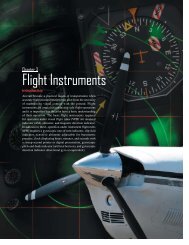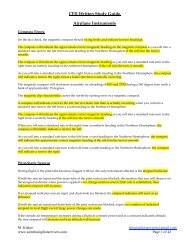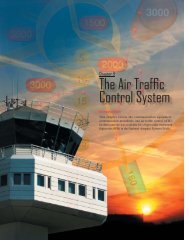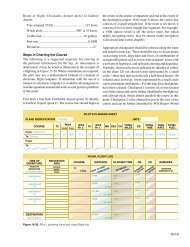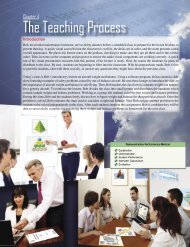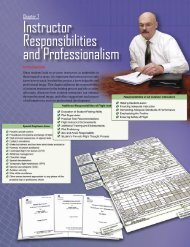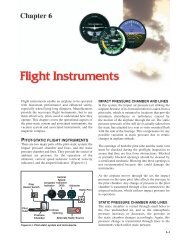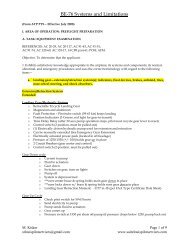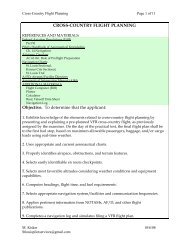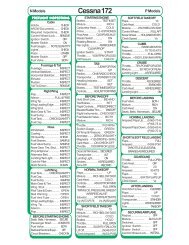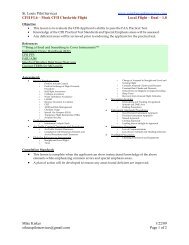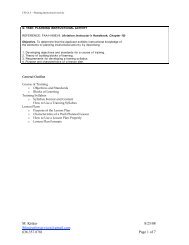PVT FL4 - Emergency Operations - St. Louis Pilot Services
PVT FL4 - Emergency Operations - St. Louis Pilot Services
PVT FL4 - Emergency Operations - St. Louis Pilot Services
Create successful ePaper yourself
Turn your PDF publications into a flip-book with our unique Google optimized e-Paper software.
<strong>St</strong>. <strong>Louis</strong> <strong>Pilot</strong> <strong>Services</strong><br />
www.saintlouispilotservices.com<br />
<strong>PVT</strong> <strong>FL4</strong> – <strong>Emergency</strong> <strong>Operations</strong> 636.357.8781<br />
Objective<br />
• Practice the maneuvers listed for review to gain additional proficiency and demonstrate<br />
the ability to recognize and recover from stalls.<br />
• The student will also receive instruction and practice in the maneuvers and procedures<br />
listed for introduction, including emergency operations and additional practice of airplane<br />
control by instrument reference (IR).<br />
• Instructor may demonstrate secondary, accelerated maneuver, crossed-controlled, and<br />
elevator trim stalls.<br />
• Emphasis will be on procedures related to airport operations, steep turns, slow flight,<br />
stalls and stall recovery.<br />
References<br />
New This Lesson<br />
• Workload management<br />
• <strong>Pilot</strong>-in-Command Responsibilities<br />
• <strong>Emergency</strong> Approach and Landing (simulated)<br />
• Systems and Equipment Malfunctions<br />
• <strong>Emergency</strong> Equipment and Survival Gear<br />
• <strong>St</strong>eep Turns<br />
• Demonstrated <strong>St</strong>alls (Secondary, Accelerated, Crossed-Control, and Elevator Trim)<br />
Review This Lesson<br />
• Wake turbulence avoidance<br />
• Climbing and Descending Turns (VR)(IR)<br />
• Airport, Runway, and Taxiway Signs, Markings, and Lighting<br />
• Collision Avoidance Precautions<br />
• Normal Takeoffs and Landings<br />
• <strong>St</strong>all and Spin Awareness<br />
• Maneuvering During Slow Flight<br />
• Power-Off <strong>St</strong>alls<br />
• Power-On <strong>St</strong>alls<br />
• Traffic Patterns<br />
Mike Kisker 8/28/08<br />
stlouispilotservices@gmail.com
<strong>St</strong>. <strong>Louis</strong> <strong>Pilot</strong> <strong>Services</strong><br />
www.saintlouispilotservices.com<br />
<strong>PVT</strong> <strong>FL4</strong> – <strong>Emergency</strong> <strong>Operations</strong> 636.357.8781<br />
Special Emphasis Area: Workload management<br />
REFERENCE:<br />
<strong>Pilot</strong>’s Handbook of Aeronautical Knowledge (PHAK)<br />
Chapter 16, p. 8<br />
Workload Management<br />
• Effective workload management ensures that essential operations are accomplished by<br />
planning, prioritizing, and sequencing tasks to avoid work overload<br />
• Prepare for high workload periods during times of low workload<br />
• “Aviate, Navigate, Communicate”<br />
Mike Kisker 8/28/08<br />
stlouispilotservices@gmail.com
<strong>St</strong>. <strong>Louis</strong> <strong>Pilot</strong> <strong>Services</strong><br />
www.saintlouispilotservices.com<br />
<strong>PVT</strong> <strong>FL4</strong> – <strong>Emergency</strong> <strong>Operations</strong> 636.357.8781<br />
<strong>Pilot</strong>-in-Command Responsibilities<br />
REFERENCE:<br />
Federal Aviation Regulations<br />
91.3: Responsibility and Authority of the <strong>Pilot</strong> in Command<br />
§ 91.3 Responsibility and authority of the pilot in command.<br />
(a) The pilot in command of an aircraft is directly responsible for, and is the final<br />
authority as to, the operation of that aircraft.<br />
(b) In an in-flight emergency requiring immediate action, the pilot in command<br />
may deviate from any rule of this part to the extent required to meet that<br />
emergency.<br />
(c) Each pilot in command who deviates from a rule under paragraph (b) of this<br />
section shall, upon the request of the Administrator, send a written report of that<br />
deviation to the Administrator.<br />
Mike Kisker 8/28/08<br />
stlouispilotservices@gmail.com
<strong>St</strong>. <strong>Louis</strong> <strong>Pilot</strong> <strong>Services</strong><br />
www.saintlouispilotservices.com<br />
<strong>PVT</strong> <strong>FL4</strong> – <strong>Emergency</strong> <strong>Operations</strong> 636.357.8781<br />
EMERGENCY APPROACH AND LANDING (SIMULATED)<br />
REFERENCES:<br />
Airplane Flying Handbook<br />
8-25: <strong>Emergency</strong> Approaches and Landings<br />
10-8: Night Emergencies<br />
<strong>Pilot</strong>’s Operating Handbook<br />
Chapter 3: <strong>Emergency</strong> Procedures<br />
Objective. To determine that the applicant:<br />
1. Exhibits knowledge of the elements related to emergency approach and landing procedures.<br />
2. Analyzes the situation and selects an appropriate course of action.<br />
3. Establishes and maintains the recommended best-glide airspeed, ±10 knots.<br />
4. Selects a suitable landing area.<br />
5. Plans and follows a flight pattern to the selected landing area considering altitude, wind, terrain, and obstructions.<br />
6. Prepares for landing, or go-around, as specified by the examiner.<br />
7. Follows the appropriate checklist.<br />
Mike Kisker 8/28/08<br />
stlouispilotservices@gmail.com
<strong>St</strong>. <strong>Louis</strong> <strong>Pilot</strong> <strong>Services</strong><br />
www.saintlouispilotservices.com<br />
<strong>PVT</strong> <strong>FL4</strong> – <strong>Emergency</strong> <strong>Operations</strong> 636.357.8781<br />
SYSTEMS AND EQUIPMENT MALFUNCTIONS<br />
REFERENCES:<br />
Airplane Flying Handbook:<br />
Chapter 16: <strong>Emergency</strong> Procedures<br />
<strong>Pilot</strong>’s Operating Handbook (POH)<br />
Section 3: <strong>Emergency</strong> Procedures<br />
Objective. To determine that the applicant:<br />
1. Exhibits knowledge of the elements related to system and equipment malfunctions appropriate to the airplane<br />
provided for the practical test.<br />
2. Analyzes the situation and takes appropriate action for simulated emergencies appropriate to the airplane<br />
provided for the practical test for at least three (3) of the following—<br />
a. partial or complete power loss.<br />
b. engine roughness or overheat.<br />
c. carburetor or induction icing.<br />
d. loss of oil pressure.<br />
e. fuel starvation.<br />
f. electrical malfunction.<br />
g. vacuum/pressure, and associated flight instruments malfunction.<br />
h. Pitot/static.<br />
i. landing gear or flap malfunction.<br />
j. inoperative trim.<br />
k. inadvertent door or window opening.<br />
l. structural icing.<br />
m. smoke/fire/engine compartment fire.<br />
n. any other emergency appropriate to the airplane.<br />
3. Follows the appropriate checklist or procedure.<br />
Mike Kisker 8/28/08<br />
stlouispilotservices@gmail.com
<strong>St</strong>. <strong>Louis</strong> <strong>Pilot</strong> <strong>Services</strong><br />
www.saintlouispilotservices.com<br />
<strong>PVT</strong> <strong>FL4</strong> – <strong>Emergency</strong> <strong>Operations</strong> 636.357.8781<br />
EMERGENCY EQUIPMENT AND SURVIVAL GEAR<br />
REFERENCES<br />
Federal Aviation Regulations (FAR)<br />
91.107: Use of Safety Belts, Shoulder Harnesses, and Child Restraint Systems<br />
91.205: Instrument and Equipment Requirements<br />
91.207: <strong>Emergency</strong> Locator Transmitters<br />
91.211: Supplemental Oxygen<br />
Airplane Flying Handbook<br />
Chapter 16: <strong>Emergency</strong> Procedures<br />
<strong>Pilot</strong>’s Operating Handbook<br />
Section 3: <strong>Emergency</strong> Procedures<br />
Section 6: Weight & Balance/Equipment List<br />
Section 7: Systems<br />
Objective. To determine that the applicant:<br />
Exhibits knowledge of the elements related to emergency equipment<br />
and survival gear appropriate to the airplane and environment encountered during flight. Identifies<br />
appropriate equipment that should be aboard the airplane.<br />
Mike Kisker 8/28/08<br />
stlouispilotservices@gmail.com
<strong>St</strong>. <strong>Louis</strong> <strong>Pilot</strong> <strong>Services</strong><br />
www.saintlouispilotservices.com<br />
<strong>PVT</strong> <strong>FL4</strong> – <strong>Emergency</strong> <strong>Operations</strong> 636.357.8781<br />
STEEP TURNS<br />
REFERENCES:<br />
Private <strong>Pilot</strong> Practical Test <strong>St</strong>andards (PTS)<br />
Airplane Flying Handbook<br />
Chapter 9, page 1: <strong>St</strong>eep Turns<br />
<strong>Pilot</strong>’s Operating Handbook (POH)<br />
Section 2: Limitations<br />
Objective. To determine that the applicant:<br />
1. Exhibits knowledge of the elements related to steep turns.<br />
2. Establishes the manufacturer’s recommended airspeed or if one is not stated, a safe airspeed not to exceed VA.<br />
3. Rolls into a coordinated 360° turn; maintains a 45° bank.<br />
4. Performs the task in the opposite direction, as specified by the examiner.<br />
5. Divides attention between airplane control and orientation.<br />
6. Maintains the entry altitude, ±100 feet (30 meters), airspeed, ±10 knots, bank, ±5°; and rolls out on the entry<br />
heading, ±10°.<br />
Mike Kisker 8/28/08<br />
stlouispilotservices@gmail.com
<strong>St</strong>. <strong>Louis</strong> <strong>Pilot</strong> <strong>Services</strong><br />
www.saintlouispilotservices.com<br />
<strong>PVT</strong> <strong>FL4</strong> – <strong>Emergency</strong> <strong>Operations</strong> 636.357.8781<br />
•<br />
• Demonstrated <strong>St</strong>alls (Secondary, Accelerated, Crossed-Control, and Elevator Trim)<br />
D. TASK: CROSSED-CONTROL STALLS (DEMONSTRATION)<br />
REFERENCES:<br />
Airplane Flying Handbook<br />
FAA-S-8081-12,<br />
FAA-S-8081-14;<br />
<strong>Pilot</strong>’s Operating Handbook<br />
Objective. To determine that the Instructor:<br />
1. Exhibits instructional knowledge of the elements of crossed-control stalls, with the landing gear<br />
extended by describing—<br />
a. aerodynamics of crossed-control stalls.<br />
b. ef fects of crossed controls in gliding or reduced airspeed descending turns.<br />
c. flight situations where unintentional crossed-control stalls may occur.<br />
d. entry procedure and minimum entry altitude.<br />
e. recognition of crossed-control stalls.<br />
f. recovery procedure and minimum recovery altitude.<br />
2. Exhibits instructional knowledge of common errors related to crossed-control stalls, with the landing<br />
gear extended by describing—<br />
a. failure to establish selected configuration prior to entry.<br />
b. failure to establish a crossed-control turn and stall condition that will adequately demonstrate<br />
the hazards of a crossed-control stall.<br />
stall.<br />
c. improper or inadequate demonstration of the recognition and recovery from a cross-control<br />
d. failure to present simulated student instruction that emphasizes the hazards of a cross-control<br />
condition in a gliding or reduced airspeed condition.<br />
3. Demonstrates and simultaneously explains a crossed-control stall, with the landing gear extended,<br />
from an instructional standpoint.<br />
4. Analyzes and corrects simulated common errors related to a crossedcontrol<br />
stall with the landing gear extended.<br />
ELEVATOR TRIM STALLS (DEMONSTRATION)<br />
REFERENCES: FAA-H-8083-3; FAA-S-8081-12, FAA-S-8081-14; POH/AFM.<br />
Objective. To determine that the Instructor:<br />
1. Exhibits instructional knowledge of the elements of elevator trim stalls, in<br />
Mike Kisker 8/28/08<br />
stlouispilotservices@gmail.com
<strong>St</strong>. <strong>Louis</strong> <strong>Pilot</strong> <strong>Services</strong><br />
www.saintlouispilotservices.com<br />
<strong>PVT</strong> <strong>FL4</strong> – <strong>Emergency</strong> <strong>Operations</strong> 636.357.8781<br />
selected landing gear and flap configurations by describing—<br />
a. aerodynamics of elevator trim stalls.<br />
b. hazards of inadequate control pressures to compensate for thrust,<br />
torque, and up-elevator trim during go-around and other related<br />
maneuvers.<br />
c. entry procedure and minimum entry altitude.<br />
d. recognition of elevator trim stalls.<br />
e. importance of recovering from an elevator trim stall immediately upon<br />
recognition.<br />
2. Exhibits instructional knowledge of common errors related to elevator trim<br />
stalls, in selected landing gear and flap configurations by describing—<br />
a. failure to present simulated student instruction that adequately<br />
emphasizes the hazards of poor correction for torque and up-elevator<br />
trim during go-around and other maneuvers.<br />
b. failure to establish selected configuration prior to entry.<br />
c. improper or inadequate demonstration of the recognition of and the<br />
recovery from an elevator trim stall.<br />
3. Demonstrates and simultaneously explains elevator trim stalls, in selected<br />
landing gear and flap configurations, from an instructional standpoint.<br />
4. Analyzes and corrects simulated common errors related to elevator trim<br />
stalls in selected landing gear and flap configurations.<br />
F. TASK: SECONDARY STALLS (DEMONSTRATION) (ASEL and ASES)<br />
REFERENCES: FAA-H-8083-3; FAA-S-8081-12, FAA-S-8081-14; POH/AFM.<br />
Objective. To determine that the applicant:<br />
1. Exhibits instructional knowledge of the elements of secondary stalls, in<br />
selected landing gear and flap configurations by describing—<br />
a. aerodynamics of secondary stalls.<br />
b. flight situations where secondary stalls may occur.<br />
c. hazards of secondary stalls during normal stall or spin recovery.<br />
d. entry procedure and minimum entry altitude.<br />
e. recognition of a secondary stall.<br />
f. recovery procedure and minimum recovery altitude.<br />
2. Exhibits instructional knowledge of common errors related to secondary<br />
stalls, in selected landing gear and flap configurations by describing—<br />
a. failure to establish selected configuration prior to entry.<br />
b. improper or inadequate demonstration of the recognition of and<br />
recovery from a secondary stall.<br />
c. failure to present simulated student instruction that adequately<br />
emphasizes the hazards of poor procedure in recovering from a<br />
primary stall.<br />
3. Demonstrates and simultaneously explains secondary stalls, in selected<br />
landing gear and flap configurations, from an instructional standpoint.<br />
4. Analyzes and corrects simulated common errors related to secondary<br />
stalls in selected landing gear and flap configurations.<br />
H. TASK: ACCELERATED MANEUVER STALLS (DEMONSTRATION) (ASEL<br />
and ASES)<br />
NOTE: This TASK shall be completed by oral examination or demonstration at<br />
discretion of examiner.<br />
REFERENCES: FAA-H-8083-3; POH/AFM.<br />
Objective. To determine that the applicant:<br />
1. Exhibits instructional knowledge of the elements of accelerated maneuver<br />
stalls by describing—<br />
a. aerodynamics of accelerated maneuver stalls.<br />
b. flight situations where accelerated maneuver stalls may occur.<br />
c. hazards of accelerated stalls during stall or spin recovery.<br />
d. entry procedure and minimum entry altitude.<br />
Mike Kisker 8/28/08<br />
stlouispilotservices@gmail.com
<strong>St</strong>. <strong>Louis</strong> <strong>Pilot</strong> <strong>Services</strong><br />
www.saintlouispilotservices.com<br />
<strong>PVT</strong> <strong>FL4</strong> – <strong>Emergency</strong> <strong>Operations</strong> 636.357.8781<br />
e. recognition of the accelerated stall.<br />
f. recovery procedure and minimum recovery altitude.<br />
2. Demonstrates and simultaneously explains accelerated maneuver stall,<br />
from an instructional standpoint—<br />
3. Exhibits instructional knowledge of common errors related to accelerated<br />
maneuver stalls by describing—<br />
a. failure to establish proper configuration prior to entry.<br />
b. improper or inadequate demonstration of the recognition of and<br />
recovery from an accelerated maneuver stall.<br />
c. Failure to present simulated student instruction that adequately<br />
emphasizes the hazards of poor procedures in recovering from an<br />
accelerated stall.<br />
4. Analyzes and corrects simulated common errors related to accelerated<br />
stalls.<br />
Mike Kisker 8/28/08<br />
stlouispilotservices@gmail.com



